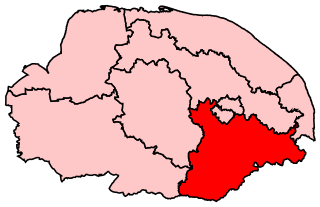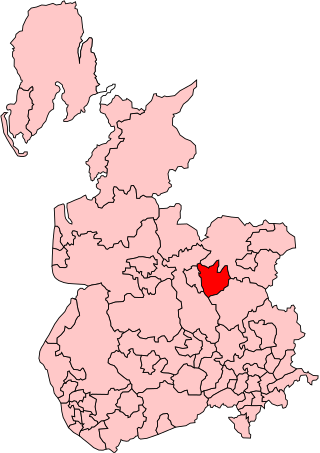
South Norfolk is a constituency represented in the House of Commons of the UK Parliament since 2001 by Richard Bacon, a Conservative.

Windsor (/ˈwɪnzə/) is a constituency in Berkshire represented in the House of Commons of the UK Parliament since 2005 by Adam Afriyie of the Conservative Party. It was re-created for the 1997 general election after it was abolished following the 1970 general election and replaced by the Windsor and Maidenhead constituency.

East Devon is a constituency represented in the House of Commons of the UK Parliament since 2019 by Simon Jupp of the Conservative Party.
Londonderry City was a parliamentary constituency in northern Ireland. It returned one Member of Parliament (MP) to the United Kingdom House of Commons, elected by the first past the post voting system.
Waterford City was a United Kingdom parliamentary constituency, in southeast Ireland.
South Tyrone was a UK Parliament constituency in Ireland which returned one Member of Parliament from 1885 to 1922, using the first past the post electoral system.
Shankill, a division of the parliamentary borough of Belfast, was a UK parliamentary constituency in Northern Ireland. It returned one Member of Parliament (MP) to the House of Commons of the United Kingdom from 1918 to 1922, on the electoral system of first past the post.
Cambridge University was a university constituency electing two members to the British House of Commons, from 1603 to 1950.
Oxford University was a university constituency electing two members to the British House of Commons, from 1603 to 1950. The last two members to represent Oxford University when it was abolished were A. P. Herbert and Arthur Salter.
London University was a university constituency electing one Member of Parliament (MP) to the House of Commons of the Parliament of the United Kingdom, from 1868 to 1950.
University of Wales was a university constituency electing one member to the House of Commons of the Parliament of the United Kingdom, from 1918 to 1950. It returned one Member of Parliament (MP), elected under the first-past-the-post voting system.

Accrington was a parliamentary constituency of the House of Commons of the Parliament of the United Kingdom from 1885 to 1983. It elected one Member of Parliament (MP) by the first-past-the-post system of election.
Isle of Ely was a county constituency represented in the House of Commons of the Parliament of the United Kingdom, centred on the Isle of Ely in Cambridgeshire. Until its abolition in 1983, it elected one Member of Parliament (MP) by the first past the post system of election.
Mid Antrim was a UK Parliament constituency in Ireland which returned one Member of Parliament from 1885 to 1922, using the first past the post electoral system.
Wandsworth Central was a parliamentary constituency in the Wandsworth district of South London. It returned one Member of Parliament (MP) to the House of Commons of the Parliament of the United Kingdom, elected by the first-past-the-post voting system.
Bournemouth East and Christchurch was a former United Kingdom Parliamentary constituency. It returned one Member of Parliament, using the first past the post electoral system from the 1950 United Kingdom general election until the constituency was abolished in 1974.
Bromley is a former constituency for the House of Commons of the Parliament of the United Kingdom. The most famous MP was Harold Macmillan, Prime Minister, 1957 to 1963.
Ramsey was a parliamentary constituency in Huntingdonshire, which elected one Member of Parliament (MP) to the House of Commons of the Parliament of the United Kingdom. It was also known as North Huntingdonshire.
Portsmouth was a borough constituency based upon the borough of Portsmouth in Hampshire. It returned two members of parliament (MPs) to the House of Commons of the Parliament of the United Kingdom, elected by the bloc vote system.





